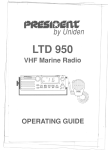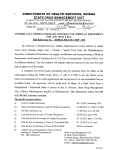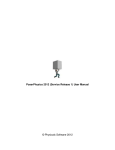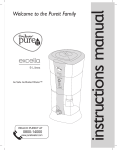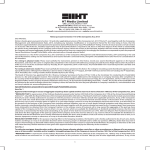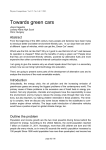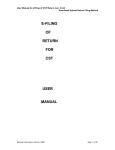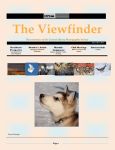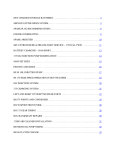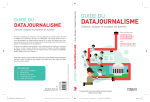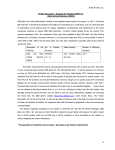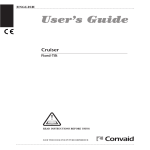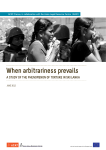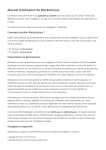Download MOST RESPECTFULLY SHOWETH 1. The present
Transcript
MOST RESPECTFULLY SHOWETH 1. The present application is being filed seeking permission of this Hon’ble Court to bring on record certain important developments which have taken place pursuant to the judgement dated (27.04.2012) in the PIL. 2. That the petitioner had filed the public interest litigation (hereinafter ‘pil’) against rampant use of black films in glasses of vehicle, which facilitate crimes of multiple nature. The govt. had been lackadaisical in its approach to contain this menace. Because of this approach of government vehicles with black films have become common in the commission of any criminal activity, more specifically terrorist activities which endangers national security. 3. The Hon’ble Court had been most kind to partially allow the writ petition and prohibit use of black films of any percentage VLT. or any other material upon safety glasses, windscreens (front and rear) and side glasses. The Hon’ble Court also ruled that - In terms of Rule 100(2), 70 per cent and 50 per cent VLT standard are relatable to the manufacture of the safety glasses for the windshields (front and rear) and the side windows respectively. 4. Post judgement the profit seeking stake holders, who include both manufacturer as well as self proclaimed representatives, of all traders connected with the trade of black films, have filed applications seeking both impleadment as well as modification in and recall of - judgement of the Hon’ble Court, by filling of I.A. in way of a customized presentation, which is contrary to the interpretation of the Hon’ble Court and the contents of the I. A. filed by the applicants, also is reflective of a possible scenario, that the Hon’ble Court without application of it’s own wits has relied only on the presentation of the petitioner. The applicants have overlooked the fact that the credible judgement of the Hon’ble Court has been delivered after a month of the final hearing on (26/03/2012) and has inputs which justify the judgement and as a matter of fact, some of the inputs were not there in the petition. Moreover the profit seeking applicants have gone ahead with the filing of I.A. despite the known facts that – a) That both Ministry of Home (which is responsible for internal security) and Ministry of Road Transport & Highways (which is responsible to frame new laws and implement existing laws related to vehicles) were respondents in the petition. b) The traders of car accessories were most daringly in gross violation of rules were both recommending, selling and installing films, which blocked visibility inside vehicles, and restricted themselves only when, judgement was delivered to remove the films from glasses of vehicles. They also actively aided to multiple instances of crimes committed under the camouflage of films (which blocked visibility inside the vehicles) both by the way of facilitating installation and never seeking restriction. However now when they are at the receiving end of law, they have incorporated customized initiatives to defeat the purpose of the petition. 5. That on (08/05/2012) Mr. Rajesh Kumar (AOR.) extended copies of I.A. for impleadment as well as modification (on behalf of the trade representatives) to the petitioner and further on (04/06/2012) again Mr. Rajesh Kumar (AOR.) extended copies of I.A. for impleadment as well as modification and recall (on behalf of manufacturer). 6. That the petitioner has framed a detailed reply to the application dated (04/06/2012) of the manufacturer, as because it was extended at a latter date, by the same lawyer and hence has more inputs than the application dated (08/05/2012). 7. Impleadment Petition - Page no. (03)//Point no. (03) – the applicant submits that, they are a company applicant’s of (75) have years not standing, but the clarified/considered the following 01) Are they manufacturing suncontrol films since last (75) years. 8. Impleadment Petition - Page no. (03)//Point no. (04) – the applicant submits that, they exports suncontrol films to over (80) contries in the world, but the applicant’s have not clarified/considered the following – 01) Do they export suncontrol films only for vehicles or some other purposes as well, like window tinting for houses. 9. Impleadment Petition - Page no. (07)//Point no. (08) – the applicant submits that, the reference to black films in motor vehicles act. was not made since the same was not in fashion in the nation, but the applicant’s have not clarified/considered the following 01) Why visibility percentage was defined ?? Was it because occupants of cars were reporting of skin cancer or because black films were considered a menace. Following are the notings as to why the rule (100) was made effective and the same can downloaded from the undermentioned link – be http://www.delhitrafficpolice.nic.in/articles/thetinted-tale.htm Provisions against the use of tinted glasses were incorporated under rule (100) of the central motor vehicle rules (1989) which read - the glass of the front windscreen and side and rear windows of every motor vehicle shall be such and maintained in such condition as to be clearly transparent and allow the driver a clear vision to the front and to the sides and through the prescribed mirror to the rear of the vehicle. Enforcement of this rule was not immediate. However, following a series of criminals cases in which the use vehicles with tinted glasses was observed during the early (1990s) when the government decided to crack down on such tinted activity, it was then observed that there were no clear cut directions in the rule prescribing or defining the minimum level of transparency to be ensured nor was there any equipment available with the enforcing authorities to measure the same. Consequently the then traffic mangers of Delhi adopted an ingenious campaign against the use of tinted glasses by merely publicizing the provisions of law and putting the fear of god in the minds of those who did not conform with veiled threats of the penal consequences merely through advisory memos. An almost (90) percent success rate was achieved despite a raging debate in the media on the pros and cons of enforcement against use of tinted glass midst wide raging protests and supports with some labeling the entire exercises nothing short of quixotic. Simultaneously though the Delhi traffic police took up the matter with the union ministry to remedy the ambiguity and consequently came the (1993) amendment to the rule which laid down that - the glass of the windscreen or the rear the window to be such that the visual transmission of light is not less then (70) percent while glass used for side windows to be of not more than (50) percent capacity. Panel enforcement activities against tinted glasses then commenced though not without some measure of opposition from some diehards. 10. Impleadment Petition - Page no. (09)//Point no. (09) – the applicant submits that, the following in mv. act. - windows of every motor vehicle shall be such and shall be maintained in such a condition that the visual transmission of light is not less than ….., meant that – use of any other article (to achieve the prohibited, prescribed but the standard) applicant’s was not have not clarified/considered the following 01) Meaning of shall be such and shall be maintained in such a condition ……. which implies that if shall be such = (x) then has to be maintained in condition (x). No where it is mentioned that users are at liberty to change the condition with any new input they deem fit. Further it also means that the condition of the windows when the cars are rolled out of the manufacturing facility has to be maintained the same thereafter. 11. Modification Petition - Page no. (03)//Point no. (03) – the applicant submits that, the tinting films have multiple benefits, but the applicant’s have not clarified/considered the following - 01) Whether tinted glasses without tinted films (pasted on the surface of glass) can achieve the same benefits or not. 02) That (UV) rays also help in formation of vitamin (D) is not mentioned. Http://en.wikipedia.org/wiki/ultraviolet 03) That (97%) of (UV) rays get filtered in the atmosphere is not mentioned. Http://en.wikipedia.org/wiki/ultraviolet 04) That even clear glasses filter (UV) rays is not mentioned. http://www.physlink.com/education/askexperts/ ae603.cfm 12. Modification Petition - Page no.s (04 & 05)//Point no.s (04 & 05) – the applicant submits on the employment figures and the turnover, but the applicant’s following have (the not same clarified/considered reference is the given in impleadment petition also) 01) Credible data to support their claims. 02) Is it with reference to tinting films as a whole or only tinting films related to glasses of vehicles (which also includes films used for manufacturing laminated glasses). 03) Whether the shops only sell tinted films or other car accessories as well. 13. Modification Petition - Page no.s (06, 07, 08 & 09)//Point no.s (06, 07 & 08) – the applicant has pointed out that the judgement was not in tune with the prayers, but the applicant’s have not clarified/considered the following (some similar references are given in impleadment petition also) 01) That the prayer to pass any other order which the Hon’ble Court may deem fit in the facts and circumstances of this case – was also made to the Hon’ble Court. 02) Public Interest Litigation is not an adverse litigation between private parties and is intended to benefit the larger public interest and hence courts (being custodian of law) also take suo moto action in such litigations. 03) There is an allegation on part of applicant that no where in the order it has come out as to what is meant by black film. The para (03) of the judgement reads as follows - the word `tinted' means shade or hue as per the dictionary. The rear and front and side glasses of vehicles are provided with such shade or tint, and therefore, they are widely referred to as `tinted glasses', which is different from `black films'. The glasses of the vehicles having a coating of black films cannot be termed as `tinted glasses' because they are not manufactured as such. From the lines it is clear that black films are such films which are shaded and not fully transparent. 04) The applicant has not understood, as to why the prayer to implead media agencies was made whereas the only reason to pray for impleading them, was to verify the media reports on cases of kidnapping and rape inside vehicles and also that of ban on tinting of glasses in some countries, should the court or respondents had any doubt on the authenticity of such documents and hence a reference to Kolkata High Court order to implead media agencies in a Pil.s based on newspapers reports, was given. 05) How the Home Ministry (responsible for security) and most. (responsible for all laws regarding motor vehicles) are not the right parties, when laws universally framed (they by have them not are followed objected to the observations of the hon’ble court) and if as manufacturers the applicants are negatively affected parties, then what about impleadment of those whose children had been kidnapped and women folk raped, by aid of black films. 14. Modification Petition - Page no.s (10, 11, 12, 13, 14 & 15)//Point no.s (09, 10 & 11) – the applicant (a profit seeking stake holder) has interpreted the rule (100) as per his understanding and suitability, contrary to the understanding of the hon’ble highest court of the nation as is evident in the detailed order (with inputs more than what was mentioned in the petition) but the applicant’s have not clarified/considered the following – 01) Para (11) of the judgement - from the above provisions, it is clear that the rules deal with every minute detail of construction maintenance of a Vehicle. In other words, the and standards, sizes and specifications which the manufacturer of a vehicle is required to adhere to while manufacturing the vehicle are exhaustively dealt with under the rules. What is permitted has been specifically provided for and what has not been specifically stated would obviously be deemed to have been excluded from these rules. It would neither be permissible nor possible for the court to read into these statutory provisions, what is not specifically provided for. These are the specifications which are in consonance with the prescribed is no. 2553-part 2 of 1992 and nothing is ambiguous or uncertain. 02) Para (12) of the judgement - these provisions demonstrate the extent of minuteness in the rules and the efforts of the framers to ensure, not only the appropriate manner of construction and maintenance of vehicle, but also the safety of other users of the road. 03) Para (17) of the judgement - on the plain reading of the rule, it is clear that car must have safety glass having vlt at the time of manufacturing 70 per cent for windscreen and 50 per cent for side windows. It should be so maintained in that condition thereafter. In other words, the rule not impliedly, but specifically, prohibits alteration of such vlt by any means subsequent to its manufacturing. 04) Para (19) of the judgement - even if we assume, for the sake of argument, that rule 100 is capable of any interpretation, then this court should give it an interpretation which would serve the legislative intent and the object of framing such rules, in preference to one which would frustrate the very purpose of enacting the rules as well as undermining the public safety and interest. Use of these black films have been proved to be criminal's paradise and a social evil. 05) Para (22) of the judgement - Rule 100(2) specifies the Vlt. percentage of the glasses at the time of manufacture and to be so maintained even thereafter. 15. Modification Petition - Page no. (15)//Point no. (11) – the applicant (a profit seeking stake holder) submits that, because of the ban on black film the entire film manufacturing industry will shut down and hence the film in laminated tinted glasses will not be in supply and hence the purpose of legislation i.e. CMVR. (1989) will be jeopardized. But the applicant’s have not clarified/considered the following – 01) As mentioned by the applicant in page no. (06)// point no. (06) of the impleadment petition that - out of market size of (400) crores foreign suppliers were having a turnover of (250) crores and i wonder what will stop them from servicing the Indian markets and above that if the applicant is marketing the product in (80) countries of the world with patents in (16) countries and has been winner of highest exports for last (20) years [as mentioned in page no.s (03 & 05)// point no.s (04 & 05)] then why will they at all need to stop production ?? It is a daring move of false claims to mislead the hon’ble court. 16. Modification Petition - Page no.s (17, 18 & 19)//Point no. (13) – the applicant submits that, in the replies to a RTI. query – “how many incidents of crime have been reported in which the factor of tinted glass was an input aiding the crime” and since the reply to the same was nil, hence it is proved that tinted glass is not a cause of any crime, but the applicant’s have not clarified/considered the following (a similar reference that – possibility of abuse is no ground for interference, is given in impleadment petition also) – 01) Even in cases of rape and kidnapping, the police does not record the factor of tinted glass as a cause of crime, although in the fir. It may be registered that the crime was committed in the car. 02) The stake holders in profits by way of manufacturer of black films, cannot draw their own conclusions, completely ignore the assesment of responsible police authorities (who are responsible for law and order) and also do not stand to accrue any personal material gain, from the ban on black films, unlike the applicants. 03) It is a open fact, with multiple instances of crime being reported in media on the various illegal acts. being committed under cover of black films. Undermentioned are some instances of rape and kidnapping executed in cars with black films in (2012) which were reported in some leading newspapers and the web links are also specified – From the undermentioned one needs to conclude, whether the instances of rapes, kidnapping, human trafficking, drinking, undected movement of criminals is a possibility or happenings of past and present times as well or anticipation of future (given the growth in no. Of vehicles and the lack of resources with the nation). (11/02/2012) alleged rape of (03) females in Delhi http://www.telegraphindia.com/1120211/jsp/na tion/story_15121303.jsp (27/02/2012) alleged a Delhi teenager allegedly raped by (05) friends - http://articles.timesofindia.indiatimes.com/201202-27/noida/31103409_1_class-x-girl-noidapolice-minor-victim (05/02/2012) alleged rape of woman in Kolkata – http://articles.timesofindia.indiatimes.com/201202-16/kolkata/31066093_1_night-club-gunpointyoung-woman (02/03/2012) alleged abduction and abuse of pragenent woman in Mumbai - http://lite.epaper.timesofindia.com/mobile.aspx? article=yes&pageid=8§id=edid=&edlabel=toik m&mydatehid=02-032012&pubname=&edname=&articleid=ar00802&p ublabel=toi (04/05/2012) alleged rape of woman in Ghaziabad - http://www.hindustantimes.com/indianews/uttarpradesh/girl-raped-in-ghaziabad-mallbasement/article1-850502.aspx (08/05/2012) alleged abduction of young boy in Bengal - http://www.telegraphindia.com/1120508/jsp/be ngal/story_15464595.jsp (10/05/2012) alleged rape of woman in Bengal http://timesofindia.indiatimes.com/city/kolkata/ malda-woman-dumped-on-road-after-gangrape/articleshow/13073584.cms (20/05/2012) alleged rape of girl in Haryana http://www.telegraphindia.com/1120520/jsp/na tion/story_15509622.jsp#.t7iz6uiw9rc (09/06/2012) alleged rape of woman in Kolkata http://articles.timesofindia.indiatimes.com/201206-09/kolkata/32139963_1_mumtaz-khan-exidesealdah (15/06/2012) escape of key accused in high profile Bhanwari Devi murder case with help of accomplices. That the police recovered a bolero and a scorpio used in the get away, is also mentioned - http://articles.timesofindia.indiatimes.com/201206-15/india/32253989_1_bhanwari-devi-murderjaloda-rajasthan-police (17/06/2012) a girl beaten mercilessly in New Delhi by her male friends inside (02) different moving cars, for several hours http://www.hindustantimes.com/indianews/newdelhi/delhi-girl-takes-lift-from-frienddrugged-beaten/article1-873109.aspx The copy of above mentioned media articles are annexed herewith as Annexure A-1 (colly). Pages – (71 to 99). The Indian police journal, published by the bureau of police research and development states that - crime statistics are lower than incidence because policemen are reluctant to register f.i.r. the study was conducted in North Bengal by the superintendent of police and reflected that the number of recorded cases of crime went up by more than (400%) after registration of f.i.r.s was made mandatory. Hence it can be very well be concluded that the actual nos. of criminal cases, are by far more than those reported. INCIDENTS OF HUMAN TRAFFICKING DURING 20062010 SL CRIME N HEAD O. YEAR 200 200 200 200 6 7 8 9 PERCENT AGE 201 VARIATIO 0 N IN 2010 OVER 2009 1 PROCURA TION OF MINOR GIRLS 231 253 224 237 679 186.5 2 SELLING OF GIRLS FOR PROSTITU TION 123 69 49 57 130 128.1 3 BUYING OF GIRLS FOR PROSTITU TION 35 4 0 30 32 78 4 IMMORAL TRAFFIC (PREV.) ACT 4,5 41 3,5 68 2,6 59 2,47 2,4 4 99 143.8 1.0 INCIDENCE OF CRIME AGAINST WOMEN DURING S CRIME L HEAD N O. YEAR 2006 2007 2008 2009 201 0 PERC ENTA GE VARI ATIO N IN 2010 OVER 2009 1 RAPE (SEC. 376 IPC) 19,34 20,73 21,46 8 7 7 21,39 7 22, 172 3.6 2 KIDNAP 17,41 20,41 22,93 6 9 PING & 4 ABDUC TION (SEC. 363 TO 373 IPC) 25,74 1 29, 795 15.7 3 MOLES TATION (SEC. 354 IPC) 38,71 1 40, 613 4.9 36,61 38, 7 73 4 40,41 3 2006-2010 INCIDENCE OF CRIME AGAINST CHILDREN DURING SL CRIME N HEAD O. YEAR 200 200 6 7 20 08 200 9 201 0 PERCENT AGE VARIATIO N IN 2010 OVER 2009 1 RAPE 4,7 21 5,04 5,4 5,36 5 46 8 5,48 2.2 4 2 KIDNAPPI NG & ABDUCTI ON 5,1 02 6,37 7,6 8,94 7 50 5 10,6 19.3 70 3 PROCURA TION OF MINOR GIRLS 231 2 5 3 4 BUYING 35 OF GIRLS FOR PROSTITU TION 5 22 4 237 679 186.5 40 30 32 78 143.8 SELLING 123 69 OF GIRLS FOR PROSTITU TION 49 57 130 128.1 2006-2010 The data has been sourced from the Annual Home Ministry Report for the year (2011-2012) on crime in India - http://www.mha.nic.in/pdfs/ar(e)1112.pdf 17. Modification Petition - Page no. (19)//Point no. (13) – the applicant submits that the Vlt. of glasses with films does not change during day or night, but the applicant’s have not clarified/considered the following (the same reference is given in impleadment petition also) – 01) That although the Vlt. remains at the fixed percentage, but since the quantum of visibility reduces during the night, although the Vlt. percentage remains, the same the over all visibility has to come down. For example similarly as the power of our eyes does not change with day or night but the quantum of visibility reduces. As per H. J. Roberts Md. (Who’s who in science and technology) in his book – the causes, ecology and prevention of traffic accidents has held that, a filmed windshield or rear window can reduce visibility severely especially at night. Slight tinting of the upper front windshield and rear window especially along the glass borders may help reduce both glare and vehicular temperature. But excessive tinting is undesirable because it can interfere with visual acuity and create excessive dimness on cloudy days. This goes for dusty days too. That while the equivalent loss of headlight power is (30) percent the loss of effectiveness in seeing red brake or stop lights is (60) percent as red light is transmitted through a tinted windshield with greater difficulty as compared to through an un-tinted windshield. That one can readily inspect a windshield for these features by standing in front of it and then visualising objects in or behind the car. No distortions or other irregularities should be seen. The article can be viewed by visiting the following link – http://www.delhitrafficpolice.nic.in/articles/thetinted-tale.htm 18. Modification Petition - Page no. (20)//Point no. (13) – the applicant submits that, no statistics has been provided pertaining to casualty reported in – (01) vehicles with black films. (02) vehicles without black films in day time. (03) vehicles without black film in night. But the applicant’s have not clarified/considered the following – 01) What is the source of availability of such irrational data as desired by applicants ?? 02) It seems that they want to conduct a country wide referendum as to whether tinting should be allowed through glass or by films. 03) What is also important is that not more than (30%) of vehicles have tinting on the glasses. Although there is no data to support the same but the undermentioned newspaper article in times of India – Gurgaon (20/07/2011) can throw light on the claims of the petitioner, wherein it is mentioned that only (02) out of (10) vehicles have tinting - http://articles.timesofindia.indiatimes.com/201107-20/gurgaon/29793626_1_glass-traffic-policeblack-film The copy of above mentioned media articles has been annexed herewith as Annexure A-2. Pages – (100 to 101). Further, only those who use air conditioning, do pull up the glasses & air conditioning provides cooling any ways – hence (70%) of car users were exposed to direct sunlight even before the judgement of the hon’ble court was delivered !! 19. Modification petition - Page no. (20)//Point no. (14) – the applicant submits that the inability of the police and civic administration cannot be the reason to ban the films, but the applicant’s have not clarified/considered the following (the same reference is given in impleadment petition also) – 01) Invoking a ban or making anything mandatory are similar conditions, since once any condition is made mandatory - it invariably results in complete restriction of some other condition. 02) Both invoking a ban and making anything mandatory are part of regulation. 03) Regulation can be both self imposed or imposed by rule of law. 04) Lack in availability of resources leads to regulation. 05) Even children of non prosperous parents although may enjoy the same level of freedom as children of prosperous parents enjoy, but resources can be highly regulated for the former. While the latter will enjoy the comfort of the air conditioner during hot summer the child of less prosperous will have to satisfy with fan and even load shedding. Undermentioned (point – 6) will help evaluate the dismal state of citizens of the nation and due to the lack of resources with the government, to fill up the vacum (in multiple areas) more taxes cannot be imposed on all citizens to increase police force, just for monitoring the percentage of tinting in ever growing population of vehicles, only a small percentage of which use tinted films. The applicants who now claim to be representing the welfare of all profit seeking stake holders and citizens of the nation, were executing business in the most irresponsible manner and never paid heed to the regular instances of crime happening across the length and width of nation and never adviced the profit seeking stake holders to restrain from illegal activity of tinting the glasses to opaque or sought an apology from the nation for their irresponsible acts. 06) a) In the World Economic Forum’s Annual Global Competitiveness Report (GCR) (2010- 2011), India shows up poorly in institutions, ranking - (71) in diversion of public funds; (88) in the public’s trust of politicians; (83) in irregular payments and bribes; (72) in favouritism in decisions of government officials; (57) in wastefulness of government spending; (95) in burden of government regulation; (127) in business costs of terrorism; (67) in business costs of crime and violence; (73) in organized crime; (68) in reliability of public services; (70) in ethical behavior of firms and (76) in efficacy of corporate boards. b) As per Harvard School of Public Health - India has just (01) operation theatre per (01) lac people. Further the surgical facilities available, do not have basic equipment such as oxygen monitors necessary for safe surgery. c) As per National Sample Survey Office - India has (49) thousands slums of which more than (12) thousands are located along nullahs and drains. d) As per Ac. Nielsen - only (12%) of India’s (35+) crores menstruating women use sanitary napkins and other (88%) who cannot afford the cost of the same use – unsanitized cloth, ashes and husk sand. e) As per International Multi Dimensional Poverty Index - (64.5) crores / (55%) of India’s population is poor. f) As per UNDP. - (08) Indian states account for more poor people than (26) poorest African nations taken together. g) As per Economist Intelligence Unit - care of people approaching death is worst in India. h) As per UN. - India holds the record of being home to the highest number of children who die before their (5)th birthday. i) As per FPRI. Global Hunger Index - India ranks (67) out of (84) developing nations, in having the number of hungry people among it’s citizens. j) As per Planning Commission - (09) crores and (36) lacs people reside in slums in India. k) As per FAO. - India has (23) crores undernourished people, which is (27%) of the world’s undernourished population. l) As per UNICEF. - (43%) of India’s children are under weight, which is (42%) of the world’s under weight children. m) As per Human Development Report - based on (Health Care + Education + Income) in a country, India ranks (119) among (169) countries. n) As per the latest data of the ‘Global Burden of Diseases, Injuries and Risk Factors’ study, published in British Medical Journal “The Lancet” - whereas average blood pressure declined globally, it increased among both men and women in India. o) As per medical general “The Lancet” - (30%) rural India and (20%) Urban India did not go for any treatment because of financial inability and (47%) of Rural India along with (31%) of Urban India financed hospital admission through loans and sale of assets. p) As per Medical Council of India - India has (01) doctor for every (1700) citizens, whereas Germany has (01) doctor for every (296) citizens. q) As per Planning Commission - an Urban Indian spending more than rupees (20) a day on his basic needs cannot be termed as poor. r) As per National Family & Health Survey - (23%) of married men + (52%) of married women + (72%) infants in india are anemic – hence leading to slow starvation. s) As per UNO. - India’s population will stand at (170+) crores in (2060) and by (2030) will have the highest population share among nations of the globle. t) As per National Sample Survey Organisation over (03) crores Indian cannot find work despite being in labour force and another (2.5) crores Indian citizens are officially under employed as per most conserveative estimates. u) As per Transparency International Corruption Index - India dropped to (95) th position !! It reflects that how, in a reaffirmation of the general perception, India has dropped (11) places to be ranked (95)th in the Transparency International Corruption Index. v) As per National Crime Records Bureau - (21) Indian citizens kill themselves every day for reasons such as bankruptcy, unemployment and poverty. w) As per NCRB. - in (2010) there were (241986) instances of violent crimes + (134599) instances of suicides + (384649) instances of accidental deaths in India. x) As per BPRD. study - the reported instances of crime shoot up by (400%) once recording of FIR.s is made mandatory. y) As per NCRB. - sanctioned strength of police personnel in India for per lac of population is (173.5) whereas the actual strength is (131.4) for per lac of population and infact some states have not more than (70) police personnel for every lac of it’s citizens. z) As per Global Peace Index (GPI) (2011) - which ranks countries according to how peaceful they are. India now ranks (135) out of (153) countries. We are now amongst the (20) least peaceful nations in the world, along with countries such as Pakistan and Afghanistan. The above mentioned parameters (a to z) will help, rightly evaluate the shortage of resources, at the disposal of the government, which can deliver uniform welfare to the citizens. 20. Modification Petition - Page no.s (21 & 22)//Point no. (15) – the applicant has defined the difference between safety glass and laminated safety glass as per his own understanding, but the applicant’s have not clarified/considered the following – 01) Para (17) of the judgement - however, the prayer relating to issuance of directions prohibiting use of black films on the glasses of vehicles certainly has merit. On the plain reading of the rule, it is clear that car must have safety glass having vlt at the time of manufacturing 70 per cent for windscreen and 50 per cent for side windows. It should be so maintained in that condition thereafter. In other words, the rule not impliedly, but specifically, prohibits alteration of such vlt by any means subsequent to its manufacturing. How and what will be a "safety glass" has been explained in explanation to rule 100. The explanation while defining `laminated safety glass' makes it clear that two or more pieces of glass held together by an intervening layers of plastic materials so that the glass is held together in the event of impact. The rule and the explanation do not contemplate or give any leeway to the manufacturer or user of the vehicle to, in any manner, tamper with the vlt. The rule and the is only specify the vlt of the glass itself. 21. Modification Petition - Page no.s (22 & 23)//Point no. (16) – the applicant has expressed disagreement with the rationale that - chances of accident increase by a given percentage due to low visibility and further that although china has more vehicles on roads it has not banned black films, but the applicant’s have not clarified/considered the following – 01) As per H. J. Roberts Md. (Who’s who in science and technology) in his book – the causes, ecology and prevention of traffic accidents has held that, a filmed windshield or rear window can reduce visibility severely especially at night. Slight tinting of the upper front windshield and rear window especially along the glass borders may help reduce both glare and vehicular temperature. But excessive tinting is undesirable because it can interfere with visual acuity and create excessive dimness on cloudy days. This goes for dusty days too. That while the equivalent loss of headlight power is (30) percent the loss of effectiveness in seeing red brake or stop lights is (60) percent as red light is transmitted through a tinted windshield with greater difficulty as compared to through an un-tinted windshield. That one can readily inspect a windshield for these features by standing in front of it and then visualising objects in or behind the car. No distortions or other irregularities should be seen. The article can be viewed by visiting the following link – http://www.delhitrafficpolice.nic.in/articles/thetinted-tale.htm The fact that china even though has lesser no. of vehicles than India but still has lower accident rate, can be verified by visiting the following link – http://www.medindia.net/news/india-surpasseschina-in-fatal-road-accidents-report-42830-1.htm It is noteworthy that in the Chinese capital of Beijing prohibits cars with specified last digits (of their registration numbers) from coming to streets, on certain days of the week. Further since there are cameras every where hanging from cross beams – every time a prohibited car number is caught on camera – an automatic notice for (200) yuan penalty is issued. Further out of (08) lac applicants for new registrations, only (20) thousand new registrations are allowed. The details are available on the following link – http://articles.timesofindia.indiatimes.com/201205-26/china/31869367_1_rural-areas-propertyprices-traffic What is surprising as to how the applicant is comparing nations which are international benchmarks in terms of high quality of safety and security – to India, which is way behind when averages on all parameters are compared. 22. Modification Petition - Page no. (24)//Point no. (17) – the applicant has accused that, the petitioner has misled the hon’ble court into beleiving that in some countries the ban is applicable, different. whereas But the the actual applicant’s scenario have is not clarified/considered the following – 01) tinted glass ban is also applicable in the following nations – a) Nigeria - http://www.thisdaylive.com/articles/the-ban-ontinted-vehicle-glasses/116526/ b) Nepal http://www.mastinepal.com/thread11187.html, http://www.ekantipur.com/the-kathmandupost/2011/02/10/nation/supreme-court-orderto-do-away-with-tinted-vehicleglasses/218285.html c) Uganda - http://www.ugpulse.com/ugandanews/government/police-challenged-on-tintedvehicles/3778.aspx d) Pakistan http://www.omantribune.com/index.php?page=n ews&id=30565&heading=sports, http://www.omantribune.com/index.php?page=n ews&id=26505&heading=oman, http://www.brecorder.com/top-news/108pakistan-top-news/60401-rahdari-and-tintedglass-vehicles-banned-in-balochistan.html e) Bangladesh http://www.autoblog.com/2006/03/08/banglade shs-ban-on-tinted-windows-collapses-car-trade/ http://www.daily-sun.com/details_yes_28-042012_criminals%e2%80%99-joy-ride-on-tintedglass-vehicles_128_4_1_1_2.html f) Kurdistan http://www.kurdishglobe.net/displayarticle.html?id=8017142776d102bc146889b3958 40da0 g) Sri Lanka http://www.dailymirror.lk/index.php/news/3639 -front-window-tints-banned-.html h) Afghanistan http://www.dailytimes.com.pk/default.asp?page= 2010%5c03%5c10%5cstory_10-3-2010_pg20_4 i) Belarus http://en.wikipedia.org/wiki/window_film#citeno te-10 j) Dubai [limited permission] http://gulfnews.com/news/gulf/uae/traffictransport/overtinting-of-car-windows-punishableby-law-1.1033130 k) Jordan [minimum (90%) visibility required] http://www.jordanoholic.com/blog/news/jordanban-car-tinted-windows l) Kuwait http://www.arabtimesonline.com/newsdetails/ta bid/96/smid/414/articleid/170079/reftab/69/d efault.aspx The copy of above mentioned media articles are annexed herewith as Annexure A-3 (colly). Pages – (102 to 140). The hon’ble court had rightly observed that use of black films is not prevalent (widely used) in United States of America, united kingdom & Germany. However it had never observed that the same is banned in these countries and undermentioned are the links which reflect the very strict laws governing the use of tinted films in these countries !! a) California (USA.) http://home.pcisys.net/~bpc/auto_law/tint/tint_ ca.html b) U.K. http://www.shropshiretints.co.uk/legal.htm c) Germany http://www.ehow.com/facts_5471295_germanywindow-tint-rules.html The copy of above mentioned media articles are annexed herewith as Annexure A-4 (colly). Pages – (141 to 154). What is noteworthy is that – all the neighbours of India i.e. Bangladesh, Nepal, Sri Lanka & Pakistan have banned the usage of tinted glass. 23. Modification Petition - Page no. (25)//Point no. (17) – the applicant has accused, that the petitioner has misdirected the hon’ble court into believing that all safety glasses are pre laminated, whereas the actual scenario stands different. But the applicant’s following have (the not same clarified/considered reference is the given in impleadment petition also) – 01) In page (02) point (01) of the petition the following is written – on account of this approach of the offenders/terrorists usage of vehicles with black films on their glasses ….. Similar mention is there in page (07) point (05) page (08) point (06). 24. Modification Petition - Page no.s (25 & 26)//Point no. (18) – the applicant has accused that the petitioner has given wrong information as recorded in paras (05 to 08) of the order, whereas the actual scenario stands different. But the applicant’s have not clarified/considered the following – The fact that china even though has lesser no. of vehicles than India but still has lower accident rate, can be verified by visiting the following link http://www.medindia.net/news/india-surpasseschina-in-fatal-road-accidents-report-42830-1.htm It is noteworthy that in the Chinese capital of Beijing prohibits cars with specified last digits (of their registration numbers) from coming to streets, on certain days of the week. Further since there are cameras every where hanging from cross beams – every time a prohibited car number is caught on camera – an automatic notice for (200) yuan penalty is issued. Further out of (08) lac applicants for new registrations, only (20) thousand new registrations are allowed. The details are available on the following link – http://articles.timesofindia.indiatimes.com/201205-26/china/31869367_1_rural-areas-propertyprices-traffic What is surprising as to how the applicant is comparing nations which are international benchmarks in terms of high quality of safety and security – to India, which is way behind when averages on all parameters are compared. 25. Modification Petition - Page no. (26)//Point no. (18) – the applicant has mentioned that, black films give numerous benefits to the public, like protection from cancer and saving of fuel, but the applicant’s following have (a not similar clarified/considered reference is given the in impleadment petition also) – 01) Will the same benefits not accrue from tinted glasses without black film ?? 02) A research article by department of chimestry of Jamia Milia Islamia titled – cancer scenario in India with future perspectives, throws light on the threat to India by the disease of cancer. Although its speaks at length about frequently observed cancers in India like – lung; breast; stomach; gall bladder; cervical; oral and miscellaneous cancers, but no where it talks about skin cancers and further in the statewise data on the most incidence of cancers – skin cancer is reported only by state of Chattisgarh. The data can be verified by visiting the following link - http://www.cancertherapy.org/ct/v8/a/pdf/9.ali_et_al_56-70.pdf The copy of above mentioned media article has been annexed herewith as Annexure A-5. Pages – (155 to 164). Further the website physlink.com talks about most of the (UV) radition being absorbed, by even a transparent glass and the same has been stated by – Gilles Lalancette, M.S., Physicist, Dorval, Quebec, Canada. The article is available at the following link – http://www.physlink.com/education/askexperts/ ae603.cfm The threat of skin cancer to occupants of motor vehicles without any kind of tinting has been blown out of proportion. It is noteworthy that almost all electronic devices produce varied level of radiation, but no one complains but in a matter related to national security (the stake holders in profit who were acting most irresponsibly till the date the ban was enforced) have come out with all forms of reports which can misguide the hon’ble court !! If at all (UV) rays were a major threat then invariably all traffic police constables, cricketers and players for other outdoor games apart from occupants of the cars without any form of tinting would have become skin cancer patients and disease would have reached epedimic proportions. With (70%) of Indian population living in villages and cultivating their fields during day time – if sunrays were actually a kind of threat (as is being projected) then India would have been the skin cancer capital of the world !! Moreover the applicant has not been able to furnish any data on the percentage of people in varied outdoor professions, becoming victims of skin cancer !! What is also important is that not more than (30%) of vehicles have tinting on the glasses. Although there is no data to support the same but the undermentioned newspaper article in times of India – Gurgaon (20/07/2011) can throw light on the claims of the petitioner, wherein it is mentioned that only (02) out of (10) vehicles have tinting - http://articles.timesofindia.indiatimes.com/2011- 07-20/gurgaon/29793626_1_glass-traffic-policeblack-film Further, only those who use air conditioning, do pull up the glasses & air conditioning provides cooling any ways – hence (70%) of car users were exposed to direct sunlight even before the judgement of the hon’ble court was delivered !! The applicant also talks about saving of fuel by use of tinted films, but the car makers have not stated this in their user guides – Better driving Drive habits between for fuel saving (45-55) kmph Drive slow and steady. The faster you go, the more the wind resistance your vehicle will face. It has been established by trials that you can get upto (40%) extra mileage at (40) kmph as compared to (80) kmph. Avoid accelerating or decelerating unnecessarily. Always drive in the correct gear Incorrect gear shifting can lead to as much as (20%) increase in fuel consumption. Remember : for city driving, change to a higher gear when you are sure that the engine will not have to struggle. Get into top gear as soon as possible. While braking anticipate stops Stop-and-go driving wastes fuel. When you slam on the brakes, a lot of useful energy is wasted in the form of heat. Proper synchronization of gear and accelerator is necessary for better mileage. Remember : check wheels for free rotation when your car is being serviced. Binding brakes restrict free wheel movement and the engine consumes more petrol in order to overcome resistance. Keep your foot off the clutch Use your clutch only when you change gears. Riding the clutch causes loss of energy and damages clutch lining. Remember : use your hand brakes when stopping on up gradient. Don't manipulate the clutch and accelerator to stay stationary because it wastes fuel. Periodic servicing Servicing of your vehicle must be carried out as specified in user's manual. Use the recommended spares & lubricants Always use recommended spares & lubricants Engine oil that is thicker than recommended can cause a (2%) increase in fuel consumption . Remember : check the car manual and the oil manufacturer's recommendations, before using any particular grade of oil . Clean your air filter regularly Your air filter prevents air from fouling the engine. Dust causes rapid wear of engine components and increases fuel consumption. Remember : cylinder bores and piston rings wear out faster in engines with dirty air cleaners. Clean air filters at every tune up. Do not allow leakage or spillage Loss of one drop of petrol per second can amount to loss a of (2000) litres per year. Make sure that the fuel tank cap has a good rubber seal. Don't wait for your car to warm up Instead drive in low gear till the engine warms up. Do not use the choke longer than necessary. Reduce loads Unnecessary loads increase fuel consumption. Do you really need to carry the luggage rack or various odd things in the boot all the time? Remember : a reduction of weight by about (50) kg can lead to a (2%) saving in fuel , when driving in city. Check your tyre pressure regularly Under inflated tyres increase rolling resistance which leads to higher petrol consumption & faster wear out of tyres at sides . Remember : a (25%) decrease in tyre pressure can cost you (5 -10%) more on petrol and (25%) on tyre life. When you stop your car, stop your engine Idling for an hour costs one litre of petrol always keep your car ready for starting quickly. Keep the battery , alternator & fan-belt in good condition. This will ensure a good start whenever you need it. Remember : switch off the engine at stops of over (2) minutes. Plan your route Fuel consumption on a highly congested road can be double the normal. Rush hour or stop-and-go traffic can waste fuel excessively. Remember : you will get more mileage from each litre if you take a less congested route. The above is an extract from the website of the number (01) car manufacturer of India i.e. Maruti Udyog limited and is available by visiting the following link - http://www.marutisuzuki.com/fuelefficiency.aspx Similarly for ensuring best performance of a car air conditioner, no where it is mentioned to avoid the sun, since for a vehicle (which invariably travels outdoors) avoiding the sun is indispensable. Undermentioned are some guidelines for proper maintenance of the air conditioner. A car air conditioner is a very important feature in a car. However, it is often neglected, and most people don’t know how to properly maintain it. Here are some methods of how to maintain a car air conditioner to make it work better and last longer. Refer to the car’s manual. Maintaining a car air conditioner involves knowing about the specific features of your car. Know the instructions on how to maintain the parts of the car air conditioner. Always keep the car manual in a safe place so that you can refer to it whenever you have to maintain your car air conditioner. Clean the air filter. A dirty air filter clogs up the airway and lessens the coolness of the car air conditioner. Check whether the air filter is still clean or if it needs cleaning. Take off the air filter. Clean the air filter using water and mild soap. When the air filter is very dirty, or if it has become damaged, replace the air filter with a new one. Get rid of moisture. Excess moisture causes odor and encourages the growth of mildew. Dry the evaporator core by running your car air conditioner for about an hour. Activate the defrost system for (15) minutes to rid moisture easier. Maintain the coolant pressure. Prevent the car air conditioner’s hoses from hardening up and the seals from being ruined by maintaining the coolant pressure. For once a month, run the air conditioner at the coolest temperature and the fastest fan speed for (20) minutes. The above article on proper maintenance and hence enhancing the efficiency of the air conditioner can be down loaded from the following link - http://www.howtodothings.com/automotive/ how-to-maintain-a-car-air-conditioner Further if people were so very concerned about car heating, only white and silver cars would have sold – since they are the best reflector of sunlight and additionally also ensure best road visibility, so as to prevent accidents. 26. Modification Petition - Page no. (29)//Point no. (20) – the applicant submits that, the ban in some countries is not the model for our constittution, but the applicant’s have not clarified/considered the following (the same reference is given in impleadment petition also) – 01) When a country without a constitutions can realize the menace of black films then why not we. 02) In no way the constitutional right to travel in private vehicles on public roads, is being taken away from the citizens of the nation, but only regulation imposed as is done in so many areas of travel among others. The applicants are talking of a perfect scenario of absolute freedom which no constitution can ensure, because larger interest of society always takes over individual interest. 27. Modification Petition - Page no.s (29 & 30)//Point no. (21) – the applicant submits that, it would be unrealistic to put a particular standardized norm for automobile companies in the process of manufactur, hence creating monopolized unfair market, but the applicant’s have not clarified/considered the following – 01) While booking the car the buyers can be provided with the following options – a) to opt for clear glasses. B) to opt for (70%) & (50%) visibility. C) to opt for visibility between (100%) & (70%/50%). It is noteworthy that the petitioner on (01/06/2012) has written the following letter to leading car manufacturers of India, for framing a policy in this regard, vide EW. No.s ---EW032950364IN; EW032950378IN; EW032950355IN; EW032950381IN & EW032950395IN. Supreme court order implementation (case no. 265 of 2011) : Respected Sir, This communication of mine, is to facilitate a detailed humble address, to your hon’ble chair on the above stated subject matter !! Sir, as you must have known about the supreme court order dated (27/05/12) to ban black films on glasses of vehicles - (irrespective of it’s visual light transmission) and that as per the order, only manufacturer can produce vehicles with such glasses - (which adhere to the visibility percentage as set in motor vehicles act) !! Sir, in order to avoid eating into your very valuable time, there are only (3) replies against the under mentioned queries, which are humbly desired and requested of your chair - 1]] How does the manufacturer produce tinted glass ?? Is it by colouring or by using of some kind of film ?? Further if it is film, then is it installed on the surface of the glass or there is some other mechanism ... Kindly please clarify !! 2]] What is the source of glasses being installed on the vehicles ?? Is it manufactured at a facility owned by the vehicle manufacturer or is procured from a vendor ?? (if procured from a vendor kindly please provide the name of the glass manufacturing company and also the brand). 3]] How will new customers procure vehicles with tinted glass ?? Will they be given a choice at time of booking the vehicle Further respected sir, if there is an existing ?? working mechanism in place by virtue of which (buyers of new cars) can order for cars with glasses which confirm to the norm of (70%) front visibility & (50%) side visibility, it is fine, but if the mechanism is not in place - then it is being requested of your credible chair, to develop a mechanism in interest of the consumer & also create an awareness campaign, on the method of availing cars with tinted glasses as well as on the prices for the same !! Sir, a positive action by the organization of which you are at the helm of affairs, is most humbly desired and requested and i will most respectfully acknowledge the kind gesture of yours Yours Faithfully, Avishek Goenka, (Petitioner) ##Copy of the relevant page of the judgement, is being extended for your understanding. ##My e.mail id.s are also being extended, so that !! replies by both postal & electronic mail can be extended by your credible chair. ##It is being requested of your credible authority to kindly please facilitate a reply (on existing information available with your dignified office) within (07) days of receiving this communication (both by e.mail. & postal mail). ##To view the complete judgement, of the above mentioned matter, please execute the undermentioned – 1] Visit, www.supremecourtofindia.nic.in 2] Judgements. A) Go to tab - judge name. B) Enter S.H. Kapadia (caps). C) Please choose dt. from (1 Jan 2012 to 1 May 2012). D) Reportable staus will be - all. E) Submit. F) Please study the judgements in name of Avishek Goenka. 28. Modification Petition - Page no. (30)//Point no. (22) – the applicant submits that, the Vlt. of glasses with films does not change during day or night, but the applicant’s have not clarified/considered the following (the same reference is given in impleadment petition also) – 01) That although the vlt. remains at the percentage but since the quantum of visibility reduces during the night, although the vlt. Percentage remains the same the over all visibility has to come down. For example similarly as the power of our eyes does not change with day or night but the quantum of visibility reduces. 02) As per H. J. Roberts Md. (Who’s who in science and technology) in his book – the causes, ecology and prevention of traffic accidents has held that, a filmed windshield or rear window can reduce visibility severely especially at night. Slight tinting of the upper front windshield and rear window especially along the glass borders may help reduce both glare and vehicular temperature. But excessive tinting is undesirable because it can interfere with visual acuity and create excessive dimness on cloudy days. This goes for dusty days too. That while the equivalent loss of headlight power is (30) percent the loss of effectiveness in seeing red brake or stop lights is (60) percent as red light is transmitted through a tinted windshield with greater difficulty as compared to through an un-tinted windshield. That one can readily inspect a windshield for these features by standing in front of it and then visualising objects in or behind the car. No distortions or other irregularities should be seen. The article can be viewed by visiting the following link – http://www.delhitrafficpolice.nic.in/articles/thetinted-tale.htm 29. Modification Petition - Page no.s (32, 33, 34, 35 & 36)//Point no. (25) – the applicant has referred some judgements regarding tinted glasses, but the applicant’s have not clarified/considered the following – 01) Para (21) of the judgement - in the present case as well, even if some individual interests are likely to suffer, such individual or private interests must give in to the larger public interest. It is the duty of all citizens to comply with the law. The rules are mandatory and nobody has the authority in law to mould these rules for the purposes of convenience or luxury and certainly not for crime. We may also note that a bench of this court, vide its order dated 15 th December, 1998 in civil appeal no. 3700 of 1999 titled Chandigarh administration and others V. Namit Kumar & ors., had permitted the use of `light coloured tinted glasses' only while specifically disapproving use of films on the vehicles. Subsequently, in the same case, but on a different date, another bench of this court vide its order reported at [(2004) 8 scc 446] made a direction that mandate of sub-rule (2) of rule 100 shall be kept in mind while dealing with such cases. 02) That the hon’ble supreme court was made fully aware of the both the judgements of Delhi High Court and only after (30) days of hearing the final arguments the hon’ble court has come with the judgement. From the submissions of the applicant it seems that the applicant is under a notion that the hon’ble court delivered the judgement without application of its own judicial mind and blindly relied on the submission of the petitioner. 30. Modification Petition - Page no. (37)//Point no. (27) – the applicant has put forward the view that, tinting of glasses would easily identify it to be a VIP. vehicle and expose it to higher risk, but the applicant’s have not clarified/considered the following – 01) That the hon’ble court has given exemption to only Vip.s of (z) and (z+) category of Vip.s who are universaly identified by the following – A) Escort Vehicles. B) Human Escort. C) Beacons. D) Siren. E) Vip. Number Plate. Things to note 1) The vehicle population in india has shot up from (3lac+) in (1951) to (10cr. +) in (2008) to (11cr. +) in (2009) of which cars, jeeps & taxis have increased from (1lac+) in (1951) to (1.5cr.) In (2009). One can very well imagine the helpless situation, of the security establishment given the resource constrains they have to leave with – given the fact that after the year (2000) the country has been adding nearly (1crore) vehicles in a year. Source – transport research wing (Ministry of Road Transport & Highways) - http://morth.nic.in/writereaddata/mainlinkfile/fi le420.pdf 02) Accidents cost the nation (1lac – cr.) a year which is nearly (1.5%) of the GDP. As stated by Planning Commission member Mr. B. K. Chaturvedi and reported in Times of India on (04/10/2011) - http://timesofindia.indiatimes.com/india/roadaccidents-cost-india-rs-1-lakh-crore-ayear/articleshow/10224908.cms 03) Total no. Of road accidents did rise by (2.1%) from (421628) in (2009) to (430654) in (2010) and no. of injured were (470687) in (2010) whereas the no. of people who died in (2010) due to road accidents were (133938) . Source – NCRB. - http://ncrb.nic.in/adsi2010/table-1.6.pdf 04) Vehicles behind the one (whose glasses are tinted) find it difficult to overtake, since they cannot see the road, in front of the vehicle which is to be overtaken. 05) As per study conducted by global research firm “IPSOS” terrorism was their second biggest concern of Indians with (38%) Indians agreeing to it, whereas crime and violence emerged as the third biggest cause of worry with (34%) Indians agreeing on the same and hence it can be very well concluded, that how important are the factors of peace & security to the citizens of India. http://articles.economictimes.indiatimes.com/20 12-03-13/news/31159536_1_scandalstransparency-international-indian-economy 06) Undermentioned is the comparative ranking of India in the global peace index 2012 which is prepared by Institute for Economics & Peace and ranks (158) countries of the globe. The article was published in the International Tabloid – Guardian & following is the link for the same - http://www.guardian.co.uk/news/datablog/2012 /jun/12/global-peace-index-2012 Year 2012 2011 2010 2009 2008 2007 Gpi Gpi Gpi Gpi Gpi rank rank rank rank rank rank 142 135 128 122 107 109 Country Gpi India

































































